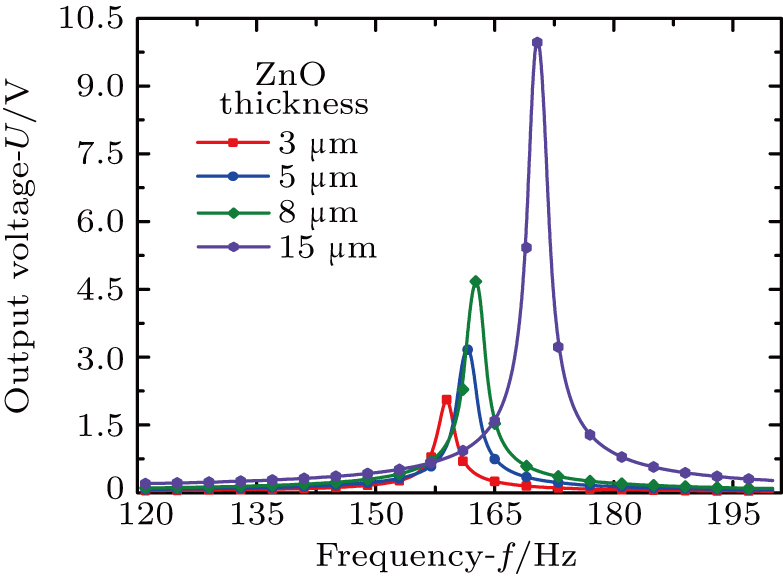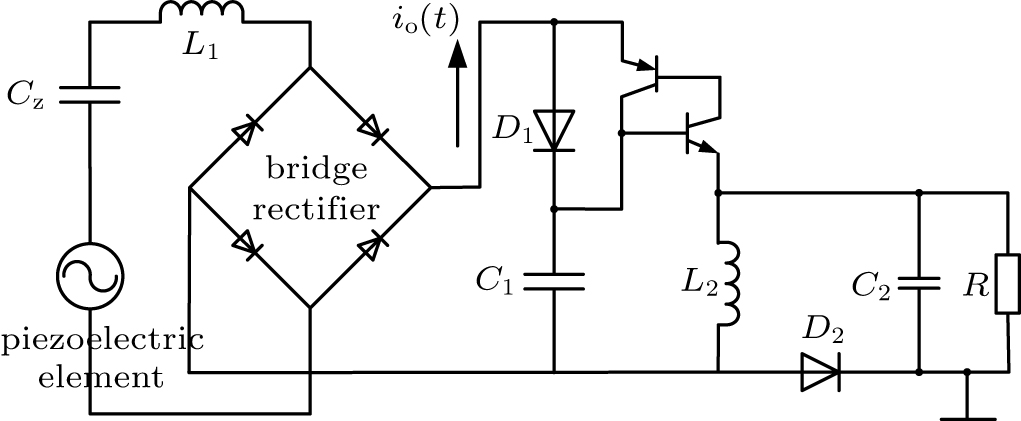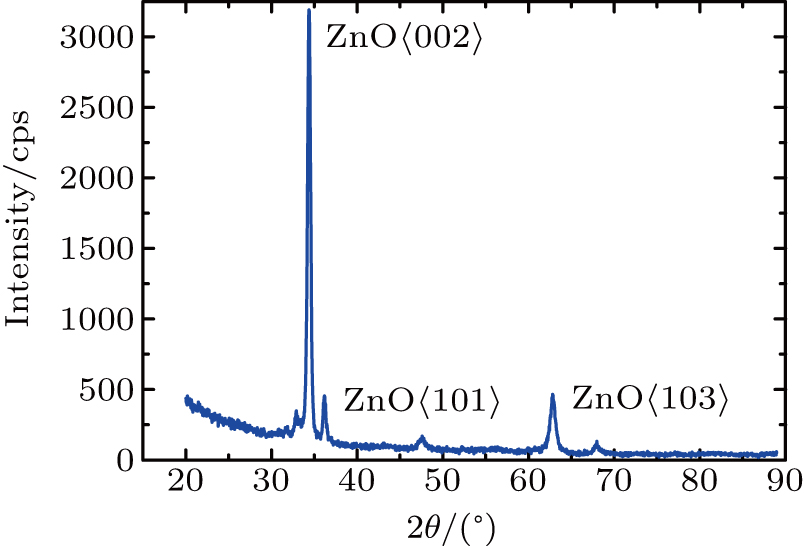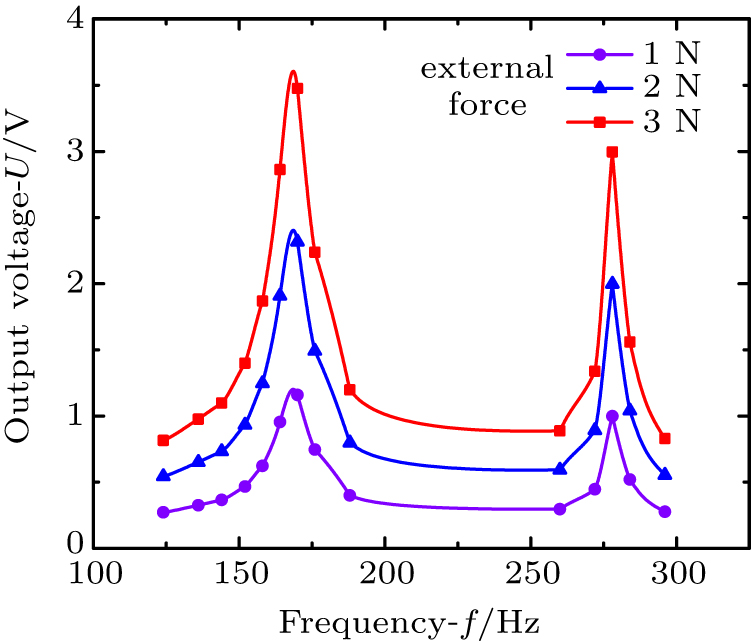† Corresponding author. E-mail:
We demonstrate a piezoelectric vibration energy harvester with the ZnO piezoelectric film and an improved synchronous electric charge extraction energy harvesting circuit on the basis of the beam-type mechanical structure, especially investigate its output performance in vibration harvesting and ability to generate charges. By establishing the theoretical model for each of vibration and circuit, the numerical results of voltage and power output are obtained. By fabricating the prototype of this harvester, the quality of the sputtered film is explored. Theoretical and experimental analyses are conducted in open-circuit and closed-circuit conditions, where the open-circuit mode refers to the voltage output in relation to the ZnO film and external excitation, and the power output of the closed-circuit mode is relevant to resistance. Experimental findings show good agreement with the theoretical ones, in the output tendency. It is observed that the properties of ZnO film achieve regularly direct proportion to output performance under different excitations. Furthermore, a maximum experimental power output of 4.5 mW in a resistance range of 3 kΩ–8 kΩ is achieved by using an improved synchronous electric charge extraction circuit. The result is not only more than three times the power output of classic circuit, but also can broaden the resistance to a large range of 5 kΩ under an identical maximum value of power output. In this study we demonstrate the fundamental mechanism of piezoelectric materials under multiple conditions and take an example to show the methods of fabricating and testing the ZnO film. Furthermore, it may contribute to a novel energy harvesting circuit with high output performance.
Piezoelectric vibration energy harvesting technology aims at collecting ambient mechanical energy and converting it into electricity efficiently. To improve the efficiency of the collection and conversion, three fundamental elements should be considered, i.e., mechanical structures, piezoelectric materials, and energy harvesting circuits.[1]
In the mechanical structures,[2–5] spiral,[6,7] dandelion,[8] cymbal,[9] diaphragm type,[10] beam-type,[11,12] and L-shaped[13] structures, etc. have been developed in order to amplify the vibration amplitude from the environment and broaden the vibration frequency range of the harvester. Of them, cantilever beam-type structure is one of the simplest and most wildly used mechanical structures with relatively high output.[14,15] Therefore, many studies on beam-type structure have been conducted to test the properties of piezoelectric materials or measure the performance of the external energy harvesting circuit.
The piezoelectric materials[16,17] are another essential factor, which can be classified as three categories: piezoelectric crystal (such as quartz crystal, etc.); piezoelectric ceramics/piezoelectric polycrystalline crystal (e.g., PZT, etc.) and new piezoelectric materials including piezoelectric polymers (e.g., PVDF, etc.), piezoelectric semiconductor (e.g., CdS, ZnO, AlN, etc.), and composite piezoelectric materials (e.g., P(VDF-TrFE), etc.[18–20] Of them, PZT[21,22] is the most extensively used materials so far. However, ZnO[23,24] needs investigating because it is made more suitable for micro-nano scale and flexible devices, especially in piezoelectric film fabrication. The ZnO film can be produced by some methods, for example film-based extension, film magnetron sputtering, sol–gel, coating methods, etc. Generally, magnetron sputtering method is adopted due to its superiority in easy control and strong adhesion.[25,26]
The properties of piezoelectric materials are essential for evaluating the ability to generate charges.[27–29] In the same way, the collecting properties of follow-up energy harvesting circuit are also essential to measuring the capacity of charge conversion and electricity storage.[30–32] An excellent energy harvesting circuit not only can make the generated charges maximally converted into electricity, but also can continuously store and convert the electricity without any external power.[33–36] Up to now, most of energy harvesting circuits have been integrated into chips for commercial applications on a large-scale, such as standard harvesting circuit, Buck–Boost harvesting circuit, synchronous electric charge extraction harvesting circuit (SECE), etc.[37–41] However, these circuits cannot be effectively obtained, because disadvantages occur in the usage of energy harvesting circuits, including power loss and additional power requirement.
In this study, we develop an output test of piezoelectric energy harvester based on a cantilever beam-type structure. By adopting the ZnO piezoelectric material, power output in material properties is investigated and film preparation process and technical tests are also implemented. A thyristor-type switch is added to the SECE energy harvesting circuit to improve the efficiency of the power conversion and reduce the power loss. The thyristor switch conduces to accomplishing the periodical charge conversion and storage by its internal electrical characteristics. The circuit is on when a positive voltage is applied to the control gate, otherwise, it is off. Moreover, this internal positive feedback mechanism of the thyristor achieves continuously working by using the capacitance and diode, which conduces to the circuit self-powered operation.
The rest of the paper is organized as follows: In Section
The beam-type device is assembled by using the components as shown in Fig.
Follow-up energy harvesting circuit is connected to the electrodes for charge conversion and electricity storage. The classic circuit of SECE[42,43] is shown in Fig.
| Table 1. Dimensions of piezoelectric components in vibrator. . |
With the internal electrical characteristics, the thyristor switch conduces to accomplishing the periodical charge conversion and storage. When a positive voltage is applied to the control gate, the thyristor is conducted, otherwise, the circuit is cut-off. Moreover, the internal positive feedback mechanism achieves continuously working by using the capacitance and diode. After that, the inductance completes the process of periodical conducting of the switch. The circuit diagram of ISECE is presented in Fig.
| Table 2. Specifications of components in ISECE circuit. . |
The theoretical mathematic models of mechanical vibration and ISECE circuit are provided in the following subsections.
Direct piezoelectric effect is utilized because the ZnO film suffers compressive and tensile stress under the vibration of the cantilever beam. Therefore, the equations with piezoelectric coefficient d31 and d33 are expressed in the form of



In order to analyze the relationship between mechanical motion and output performance, the spring-damping-mass vibration model proposed by Williams and Yates[36,44] is adopted, and the obtained results are displayed in Fig.
According to the D’Alembert’s principle in mechanical dynamics, the equation of motion in the differential form for the system can be described as













Applying Laplace transformation to Eqs. (




The working stages of ISECE circuit for measuring voltage are as follows:
In the first stage, generated charges conduct to the surface of electrodes and continuously flow into the capacitor. At the same time, the bridge rectifier is reversely biased with no output voltage. This situation lasts until the voltage across both ends of the capacitor is equal to the output voltage Vc. In the second stage, the current flows into filter capacitor and load. In this stage, the output voltage is fixed at Vc and –Vc. The interval time u between first and second stage is the duration from Vc to –Vc, determined by[45]






Beam-type piezoelectric energy harvester with ZnO film is fabricated in parts, including beam, substrate, electrodes and ZnO film. First, the general incision method is used to cut steel and Si into appropriate dimensions. Then, the flanged paste method is employed to ensure that the top and bottom Ag electrodes are stuck firmly to the ZnO film, which confirms the flatness of electrodes after connecting to wires. Next, the magnetron sputtering method is utilized to prepare the ZnO film, which is the most complicating part in this fabrication. The sputtering chamber is set in an approximate vacuum environment, and the target material ZnO is completely sputtered on the Si substrate. The conditions of the sputtering method are given in Table
| Table 3. Deposition parameters of ZnO film. . |
The properties of the film manufacturing technique are tested in two aspects. In the first aspect, roughness, grain diameter and surface topography are evaluated by an atomic force microscope (AFM) (Dimension Fastscan). With relatively low measured values, small and little particles are detected on the surface, which means that the film is smooth and homogeneous. In the second aspect, the piezoelectric properties of ZnO come from c-axis-preferred orientation of crystal lattice. Materials with good piezoelectric properties should grow intensively along the vertical c axis in microstructure. Therefore, XRD spectral line detected by x-ray diffractometer (Panalytical Empyrean) can validate the quality of ZnO preparation. And the XRD spectrum should display one strong Bragg diffraction peak.
In this work, figures
| Table 4. Surface topography testing values of ZnO film. . |
Figure
The specific functions of these devices are described below.
(I) Signal generator is adjusted to produce a sinusoidal signal and transfer it to the following power amplifier. Power amplifier as a processing unit amplifies the signal to an extent that reaches the demand of the exciter. Suitable sine wave is delivered to the vibration exciter.
(II) Vibration exciter drives the harvester vibrating together under sinusoidal wave. An accelerometer is attached to the basement in order to monitor the condition of the vibration and transfer the feedback information to the charge amplifier. The charge amplifier plays a role in amplifying the charges and feeding the signal output to PC.
(III) Direct signals output from the harvester are shown in oscilloscope including the output voltage, frequency, phase, etc. After linking with the resistance, calculated power output from the harvester is acquired by the data acquisition module for further processing.
Based on the equations in Section
Without adding follow-up circuit, the harvester can be seen as an open-circuit mode, whose output is in the form of voltage. In Eq. (
 | Fig. 10. Plots of theoretical voltage output U versus frequency f for four different thickness values of ZnO film. |
 | Fig. 11. Plots of theoretical voltage output U versus frequency f of ZnO film under four different external forces. |
Figure
Figure
According to Figs.
With adding a follow-up circuit, the harvester can be seen as a closed-circuit mode, whose output is in the form of power. In order to test the ability of ISECE circuit to generate the charges, the theoretical closed-circuit output is simulated by comparing the SECE circuit. In Subsection
Taking the power output within 16 kΩ for example, the curves in Fig.
Using the setup in Section
In the experiments, accelerations of 0.5 g–1.5 g are applied to the harvester, which can be converted into external force of 1 N–3 N by calculating with the equivalent mass of the whole device. And the corresponding voltages are presented in Fig.
Experiments on harvesting circuits are undertaken to justify the theoretical results, so it totally duplicates the theoretical results of ISECE and SECE circuits. The corresponding powers are shown in Fig.
In this study, we investigate the output performance of a piezoelectric vibration energy harvester with ZnO piezoelectric film and improve synchronous electric charge extraction energy harvesting circuit in vibration harvesting and ability to generate charges on the basis of the beam-type mechanical structure. The results are illustrated theoretically and experimentally as presented above. They have been validated to support and add to the findings of Abdelmoula and Dai,[46] in which the output performance of the cantilevered beam structure under sinusoidal harmonic excitation is displayed. The results in the paper make sense as a reference with the same condition. In consequence, the equations of output voltage and curves of output power show the same tendencies as those in this work, whose accuracy of the conclusion is proved. In addition, this work also demonstrates further output voltage and power accurately in value, which help to complete the work of Abdelmoula and Dai.[46] In the long term, this study has paved the way for improving the defection of existing energy harvesting circuits and investigating their output performances. Also, tests and fabrications of ZnO film and beam-type structure offer an example of experiments on piezoelectric harvesters. However, the cantilever beam-type structure cannot totally represent harvesters and the tests are conducted within small ranges. For example, The experiments on a large scale of frequency and resistance may not performed in the same way (Yildirim & Ghayesh, 2016).[47] Therefore, the further step in this study should be replicated with other materials and a large scale of testing data to complete and verify the research findings.
The purpose of the test is to investigate the ability of ZnO film to generate and convert charges and improve synchronous electric charge extraction circuit on the basis of the beam-type piezoelectric vibration energy harvester. The numerical results of voltage and power output are obtained through establishing the theoretical models. The theoretical analyses are simulated and the experimental tests are conducted in order to validate the accuracy of model results. In this test, a maximum open-circuit voltage is achieved at 3.6 V under 3-N force and 5-μm-thick ZnO film at a resonant frequency of 170 Hz. With 4.5-mW maximum output in a resistance range of 3 kΩ–8 kΩ, the harvester with the ISECE circuit can produce up to three times more than the power output of SECE circuit. It is indicted that the voltage of open-circuit mode increases in direct proportion to the thickness of the ZnO film and external excitation. The closed-circuit power output of the ISECE circuit is also significantly higher than that of the SECE. And the ISECE circuit can effectively enhance the sustainable capacity of maximum output. Overall, in this study we improve the synchronous electric charge extraction energy harvesting circuit and verify its excellent self-powered and low-loss properties, which will be applied to multiple energy harvesting systems. Also, in this research, we introduce the sputtered ZnO film into the beam-type harvester with the ISECE circuit, demonstrated by multiple testing methods, which can be used as an experimental technique for preparing piezoelectric materials or structures or circuits. Accordingly, the future work will focus on completing the large-scale experimental conditions by integrating multiple piezoelectric materials with novel structures.
| [1] | |
| [2] | |
| [3] | |
| [4] | |
| [5] | |
| [6] | |
| [7] | |
| [8] | |
| [9] | |
| [10] | |
| [11] | |
| [12] | |
| [13] | |
| [14] | |
| [15] | |
| [16] | |
| [17] | |
| [18] | |
| [19] | |
| [20] | |
| [21] | |
| [22] | |
| [23] | |
| [24] | |
| [25] | |
| [26] | |
| [27] | |
| [28] | |
| [29] | |
| [30] | |
| [31] | |
| [32] | |
| [33] | |
| [34] | |
| [35] | |
| [36] | |
| [37] | |
| [38] | |
| [39] | |
| [40] | |
| [41] | |
| [42] | |
| [43] | |
| [44] | |
| [45] | |
| [46] | |
| [47] |













